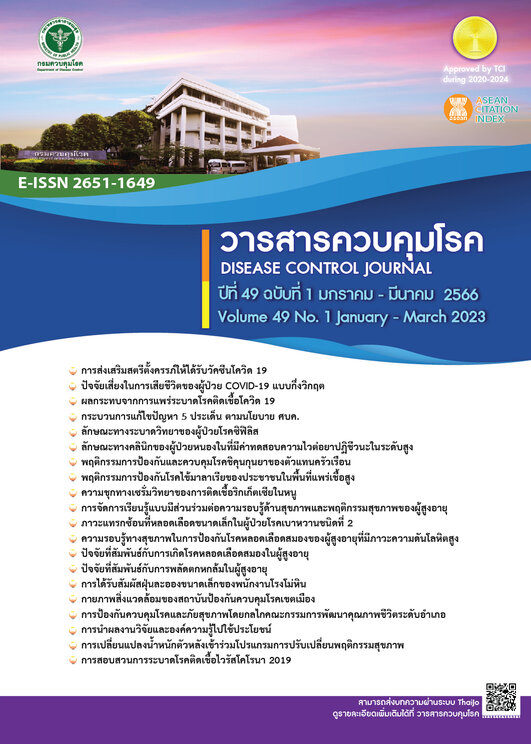Seroprevalence of Rickettsial infections in rats in the Upper South of Thailand
DOI:
https://doi.org/10.14456/dcj.2023.9Keywords:
seroprevalence, rickettsia, scrub typhus, tick typhus, murine typhus, upper south of ThailandAbstract
This study aimed to investigate the species and infection rate of rickettsioses from rodents in the upper south of Thailand. Rats were trapped and their serum samples were collected in order to detect the IgG antibody using indirect immunofluorescence assay (IFA) technique. From all of 1,050 traps, 124 traps were successful for rat capturing, which accounted for 11.81%. Twelve rodent species were identified morphologically. Rattus tanezumi was the most abundant species (70.97%), followed by Bandicota indica and Maxomys surifer (6.45%), Sundamys muelleri and Niviventer fulvescens (4.03%), R. tiomanicus and Maxomys whiteheadi (1.61%), Mus musculus castaneus, R. argentiventer, R. sladeni, N. langbiansis and Hylomys suillus siamensis (0.81%). Rickettsial infection rate was 37.90%. Based on IgG antibody tests performed on 124 serum samples, IgG antibody to scrub typhus was detected in 37.90% of the samples, whereas IgG antibody against tick typhus was observed in only 1.61% of the samples. However, no IgG antibody to murine typhus was detected. During this study, identification of tick-borne rickettsial infection, another form of scrub typhus, was of special interest. To address the issue, surveillance of scrub typhus in rodents and other potential hosts should also be carried out. In addition, biology of vectors like chiggers and ticks should be explored so that the results could be used as basic information for predicting disease incidence in the area. Besides, we can educate people on how to protect themselves if they have to travel to high-risk areas where incidence of rickettsial infections in animal reservoirs is discovered.
Downloads
References
Tay ST, Mokhtar AS, Low KC, Mohd Zain SN, Jeffery J, Abdul Aziz N, et al. Identification of rickettsiae from wild rats and cat fleas in Malaysia. Medical and Veterinary Entomology. 2014;28(1):104–8.
Comer JA, Paddock CD, Childs JE. Urban zoonoses caused by Bartonella, Coxiella, Ehrlichia, and Rickettsia species. Vector Borne Zoonotic Dis. 2001;1(2):91-118.
Thitivichianlert S, Panichkul S, Bodhidatta D, Rodkvamtook W, Sukwit S, Boonmee P, et al. Incidence of rickettsial infection in patients with acute fever in Provincial Thai army hospitals. J Med Assoc Thai. 2009;92(1):39–46.
Anannatsiri S. Rickettsioses: Scrub typhus and murine typhus. Khon Kaen: Department of Residency Training in Internal Medicine, Khon Kaen University; 2006. (in Thai)
Chakraborty S, Sarma N. Scrub Typhus: An Emerging Threat. Indian J Dermatol. 2017;62(5):478–85.
Okabayashi T, Tsutiya K, Muramatsu Y, Ueno H, Morita C. Serological survey of spotted fever group rickettsia in wild rats in Thailand in the 1970s. Microbiol Immunol. 1996;40(12):895–8.
Division of Epidemiology (TH). Annual Epidemiological Surveillance Report 2018 [Internet]. 2018. [cited 2022 Mar 7]. Available from: https://apps-doe.moph.go.th/boeeng/download/AW_Annual_Mix%206212_14_r1.pdf (in Thai)
Ekarakrungreung N, Duangngeun P, O’Reilly M, Khathasrima N, Chatpituck P, Chalamaat M, et al. Scrub typhus Outbreak among Hikers in Kao Yai National Park, Nakhon Rachasima, September 2006. Weekly Epidemiological Surveillance Report [Internet]. 2009. [cited 2022 Mar 7]. Available from: https://wesr-doe.moph.go.th/wesr_new/file/y52/Fs5222.pdf (in Thai)
World Health Organization. Plague manual: Epidemiology, distribution, surveillance and control chapter 6-7 plague surveillance [Internet]. 1999. [cited 2021 Oct 13]. Available from: https://www.medbox.org/pdf/5e148832db60a2044c2d24db
Prasartvit A. Rodents, a survey on population and control. Bangkok: The Agricultural Cooperative Federation of Thailand; 2014. (in Thai)
Rodtukkha W, Prasatwit A, Chuenjit T, Sukwit S, Youngrod S, Kajejit N, et al. A survey on animal reservoirs and scrub typhus vectors in incidence and ecotourism areas. Annual research report 2003, Military Medical Science Research Institute, Royal Thai Army Medical Department. 72-79. (in Thai)
Jaturabundit N, Chuntranon O, Thongkhao S, Pangpit S, Akethammasatian B, Tingjaronepakdee S, et al. Multi-districts Scrub Typhus Outbreak Investigation in Phang Nga Province, October-November, WESR. 2010;42(4):49-56. (in Thai)
Prasartvit A, Eamsobhana P, Rodkvamtook W, Sirisukkarn, N. Survey of Infected rate in reservoir host of Scrub Typhus and Detection of Orientia tsutsugamushi in chigger mite by polymerase chain reaction in infected areas and ecotourism areas. 2009 [Internet]. [cited 2014 Jul 9]. Available from: http://klb.ddc.moph.go.th/dataentry/research/form/627. (in Thai)
Tukrua A, Komanee P, Rodkvamtook W, Prasatvit A. Infection Rate of Typhus Fever in Rats at High-Risk Area. J Health Sci. 2015;24(6):1086-95. (in Thai)
Toanan W, Weerakhun S, Chukanhoom K, Sukon P, Saipan P. Factors associated with seroprevalence of Orientia tsutsugamushi infection in rats in Khon Kean province. KKU Vet J. 2014;24(2):187-200. (in Thai)
Department of Communicable Disease Control (TH). The survey of scrub typhus reservoir host and the identification of Chigger. Bangkok. The Printing of Agricultural Co-operative Federation of Thailand; 2001. (in Thai)
Prompiram P, Poltep K, Pamonsupornvichit S, Wongwadhunyoo W, Chamsai T, Rodkvamtook W. Rickettsiae exposure related to habitats of the oriental house rat (Rattus tanezumi, Temminck, 1844) in Salaya suburb, Thailand. Int J Parasitol Parasites Wildl. 2020;13(1):22–6.
Division of Epidemiology (TH). Annual epidemiological report Reporting on 2011 surveillance data and 2012 epidemic intelligence data [Internet] 2013. [cited 2021 Jul 9]. Available from: https://www.ecdc.europa.eu/sites/default/files/media/en/publications/Publications/annual-epidemiological-report-2013.pdf (in Thai)
Downloads
Published
How to Cite
Issue
Section
License
Copyright (c) 2023 Disease Control Journal

This work is licensed under a Creative Commons Attribution-NonCommercial-NoDerivatives 4.0 International License.
Articles published in the Disease Control Journal are considered as academic work, research or analysis of the personal opinion of the authors, not the opinion of the Thailand Department of Disease Control or editorial team. The authors must be responsible for their articles.






